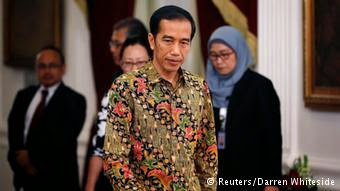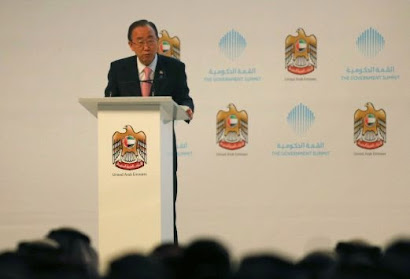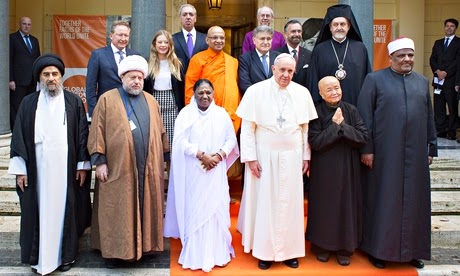Jakarta Globe, Suzannah Beiner, July 15, 2013
 |
This picture shows houses built on a the banks of a river in a slum in Jakarta
on June 11, 2013. Jakarta administration has proposed moving river-side squatters
to ‘vertical kampungs’ to alleviate annual flooding. (AFP Photo/Adek Berry) |
None of the
lecturers at the Jakarta Vertical Kampung seminar this month defined the word
“kampung.” Neither did the guests forming the panel invited to speak about
subjects related to the current state of kampungs and plans for affordable
housing.
In
Indonesian, kampung means village. But the lack of an agreed definition at the
event did not inhibit dialogue about introducing a new dimension to affordable
housing models for kampung areas: verticality.
The Jakarta
office of independent design firm SHAU initiated the master class, conference and
exhibition, all of which focused on the Jakarta Vertical Kampung. The Dutch
cultural center Erasmus Huis hosted all three events.
The July 7
conference marked the culmination of a 12-day master class between young
Indonesian architects and guest teachers, and also the opening of an exhibition
that finished on Monday.
The
exhibition showcased two collections devoted to models of redesigned kampungs
in Jakarta. One collection contained independent projects by professional
architects while the other introduced the six models made during the master
class.
High rise
village?
The
international lecturers who kicked off the conference were from diverse fields
and had differing opinions on the value in designing high-rise kampungs.
Universitas
Kristen Duta Wacana’s Eko Prawoto, the only Indonesian lecturer, and the
University of Edinburgh’s Stephen Cairns were outspoken critics of the idea
that high-rise kampungs can meet Jakarta’s need for affordable housing while
retaining the kampung identity.
Eko opened his
lecture by pointing out his lack of experience with designing high-rise
buildings. “Jogja [Yogyakarta] is low density and doesn’t have high-rise
buildings,” Eko said.
Eko
suggested architects should shift from an egocentric or Western approach when
redesigning kampungs. Instead they should look to the people living in the
community as the inspiration, in order to create designs that fit a community
rather than forcing a community to fit into a design.
“I would
like to share my thinking concerning the role of architects. It’s more about
attitude and cultural approach than purely architecture. What we can learn from
kampung is informality,” Eko said.
Eko’s
slideshow took the audience into existing kampungs, with pictures of living
conditions and adaptations.
His
one-hour time lapse of a weekend market in Surabaya generated mild laughter
from the audience as they watched a deceptively quiet courtyard burst into a
buzzing marketplace and then fade again into calm emptiness.
Homegrown
Eko was the
only lecturer to focus solely on Indonesia’s kampung culture.
According
to Eko, kampung denizens’ autonomy is critical to fostering community life and
self-governance.
“We might
think that this kind of chaotic form is not beautiful at all or that it’s very
dirty. But we can also see from a different perspective that this is a
different kind of intellectual ability,” Eko said.
One slide
presented a picture of women hanging laundry early in the morning juxtaposed
against a picture taken much later in the day of the same lines being used as
an impromptu badminton court.
“They’re
able to manage themselves, to create rules that are appropriate for the benefit
of the community. [Kampung dwellers] are able to make rules to improve [their]
living condition,” Eko said.
His final
message was one of caution.
“We need to
keep the scale to a manageable size. You have to keep in mind the available
skill sets,” he said. “We have to limit our roles as architects. We should give
people more of a chance to decide. Life is bigger than an architect.”
Cairns used
Singapore’s success with the transition to high-rises as a lens to examine the
viability of vertical kampungs in Jakarta. He found Jakarta’s existing
infrastructure came up short.
“Fifty
years ago, Singapore undertook the kampung-to-high-rise project. … It was a
very dramatic, a very traumatic and a very demanding and aggressive
transformation,” Cairns said.
Cairns
related how in 1961, a fire broke out in the Bukit Ho Swee settlement, killing
four people and completely destroying the kampung.
The
following day, Prime Minister Lee Kuan Yew had “a series of responses” that
centered on high-rise housing models.
“So, in a
way, almost overnight the transformation from kampungs to high-rises was
achieved through this highly disastrous situation,” Cairns said.
Cairns said
the transition relied on a “huge amount of bureaucratic work and technical
work” from a highly centralized state.
Cairns
noted how the Housing and Development Board (HDB) took an active role in
re-educating citizens not only “how to live in a modern way” but also how to
live accommodatingly in a multistory building.
Educational
catalogs were sent to each high-rise residence, informing the 85 percent of
Singaporeans living in them how to decorate, handle domestic tasks and operate
lifts, among other lessons.
“My
research colleague and I have published some of the kind of detail required to
sustain this kind of high-rise housing. It involves daily, weekly, monthly,
three-year, 15-year maintenance cycles to sustain the fabric of this kind of
condition,” Cairns said.
‘The most
desirable housing’
The last
lecturer at the conference was University of Seoul’s Bin Kim.
Kim
presented a converse outcome of what can happen to high-rise social housing by
examining South Korea’s rebuilding process following the Korean War of 1950 to
1953.
High-rises,
which began as affordable housing for the “native people” of Seoul, are now “the
most desirable housing in Seoul,” according to Kim.
“Apateu
started as affordable housing and is no longer affordable,” said Kim, using the
Korean word for apartment.
Kim said
that following the rapid population growth of the 1960s, the government responded
by building high-rises “in quantity over quality.”
From the
1970s to 1990s, rapid economic growth created a rise in housing development. In
turn, the government responded with the adoption of new laws to protect
development.
By 2000,
high-rises were being built on a much grander scale. Apartments began to be
constructed by private companies and branded, such as the Lotte Company’s Lotte
Castle high-rise.
“Gangnam,
you probably know that from the song by PSY, this area is the most trendy area
to live,” Kim said of the Seoul neighborhood.
High-rises
have now become so unaffordable for South Koreans that they are looking into
other types of affordable urban housing, according to Kim.
Shared
housing, where 10 or more people share the common facilities of a kitchen,
living room and recreational room, and have private bedrooms, have gained in
popularity. Other people are turning to duplex houses.
Following
the lectures, a panel of representatives from the public and private sectors
discussed topics relating to affordable housing and kampung needs.
Toward the
end of the conference, both Dutch Ambassador Tjeerd de Zwaan and Indonesian
Minister of Tourism and Creative Economy Mari Elka Pangestu gave their support
to the event, offering their views about the importance of architecture and
commending the master-class participants.
The
ambassador said he was pleased that during the master class Erasmus Huis had
been “full of action” as a hub for “Dutch professionals and young Indonesians
to interact.”
“This type
of venue is especially here to build a bridge between our two countries,
Indonesia and the Netherlands,” de Zwaan said.
The
ambassador said architects should be aware of their influence on people’s lives
and that they should design “practicable solutions.”
“The social
and economic environment of the buildings should be inspired by the people who
will live there in the future,” the ambassador said.
Questions
remain
Mari said
it was important for Jakarta to “retain and regain its character and soul” in
the pursuit of affordable housing.
“Let’s save
the villages that are in Jakarta, the kampung, before we become too affluent
and they’re gone,” the minister said.
Mari also
discussed her wish to end the long daily commutes of those people who migrated
to the suburbs because they were pushed out of the city due to rising housing
costs.
“Keep the
people in Jakarta living in the city of Jakarta and not just on the outskirts,”
she said.
Dede
Krishnadianty, a master’s student at the University of Melbourne, said she was
disappointed by the lack of government representatives in attendance.
“It’s
academic snobbery. This is a community-based participation project,” Dede said.
She
expressed frustration at the vagueness of the word kampung.
“The
government needs to differentiate the term itself. What is kampung? What are
slums?” Dede said.
“Kampung is
the culture of Indonesia.”
This
sentiment, echoed throughout the conference, will perhaps prove the most
challenging issue in addressing the housing issue. Attendees said the
preservation of culture was as important as budgetary concerns.
Six designs
were sent to Jakarta provincial administration “for next steps,” according to
the Jakarta Vertical Kampung website.



















